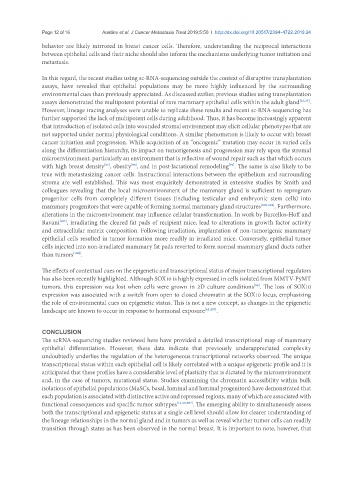Page 367 - Read Online
P. 367
Page 12 of 16 Anstine et al. J Cancer Metastasis Treat 2019;5:50 I http://dx.doi.org/10.20517/2394-4722.2019.24
behavior are likely mirrored in breast cancer cells. Therefore, understanding the reciprocal interactions
between epithelial cells and their niche should also inform the mechanisms underlying tumor initiation and
metastasis.
In this regard, the recent studies using sc-RNA-sequencing outside the context of disruptive transplantation
assays, have revealed that epithelial populations may be more highly influenced by the surrounding
environmental cues than previously appreciated. As discussed earlier, previous studies using transplantation
assays demonstrated the multipotent potential of rare mammary epithelial cells within the adult gland [22,23] .
However, lineage tracing analyses were unable to replicate these results and recent sc-RNA-sequencing has
further supported the lack of multipotent cells during adulthood. Thus, it has become increasingly apparent
that introduction of isolated cells into wounded stromal environment may elicit cellular phenotypes that are
not supported under normal physiological conditions. A similar phenomenon is likely to occur with breast
cancer initiation and progression. While acquisition of an “oncogenic” mutation may occur in varied cells
along the differentiation hierarchy, its impact on tumorigenesis and progression may rely upon the stromal
microenvironment, particularly an environment that is reflective of wound repair such as that which occurs
with high breast density , obesity , and in post-lactational remodeling . The same is also likely to be
[97]
[99]
[98]
true with metastasizing cancer cells. Instructional interactions between the epithelium and surrounding
stroma are well established. This was most exquisitely demonstrated in extensive studies by Smith and
colleagues revealing that the local microenvironment of the mammary gland is sufficient to reprogram
progenitor cells from completely different tissues (including testicular and embryonic stem cells) into
mammary progenitors that were capable of forming normal mammary gland structures [100-104] . Furthermore,
alterations in the microenvironment may influence cellular transformation. In work by Barcellos-Hoff and
Ravani , irradiating the cleared fat pads of recipient mice, lead to alterations in growth factor activity
[105]
and extracellular matrix composition. Following irradiation, implantation of non-tumorigenic mammary
epithelial cells resulted in tumor formation more readily in irradiated mice. Conversely, epithelial tumor
cells injected into non-irradiated mammary fat pads reverted to form normal mammary gland ducts rather
than tumors .
[106]
The effects of contextual cues on the epigenetic and transcriptional status of major transcriptional regulators
has also been recently highlighted. Although SOX10 is highly expressed in cells isolated from MMTV-PyMT
tumors, this expression was lost when cells were grown in 2D culture conditions . The loss of SOX10
[58]
expression was associated with a switch from open to closed chromatin at the SOX10 locus, emphasizing
the role of environmental cues on epigenetic status. This is not a new concept, as changes in the epigenetic
landscape are known to occur in response to hormonal exposure [62,107] .
CONCLUSION
The scRNA-sequencing studies reviewed here have provided a detailed transcriptional map of mammary
epithelial differentiation. However, these data indicate that previously underappreciated complexity
undoubtedly underlies the regulation of the heterogeneous transcriptional networks observed. The unique
transcriptional status within each epithelial cell is likely correlated with a unique epigenetic profile and it is
anticipated that these profiles have a considerable level of plasticity that is dictated by the microenvironment
and, in the case of tumors, mutational status. Studies examining the chromatin accessibility within bulk
isolations of epithelial populations (MaSCs, basal, luminal and luminal progenitors) have demonstrated that
each population is associated with distinctive active and repressed regions, many of which are associated with
functional consequences and specific tumor subtypes [12,58,107] . The emerging ability to simultaneously assess
both the transcriptional and epigenetic status at a single cell level should allow for clearer understanding of
the lineage relationships in the normal gland and in tumors as well as reveal whether tumor cells can readily
transition through states as has been observed in the normal breast. It is important to note, however, that

